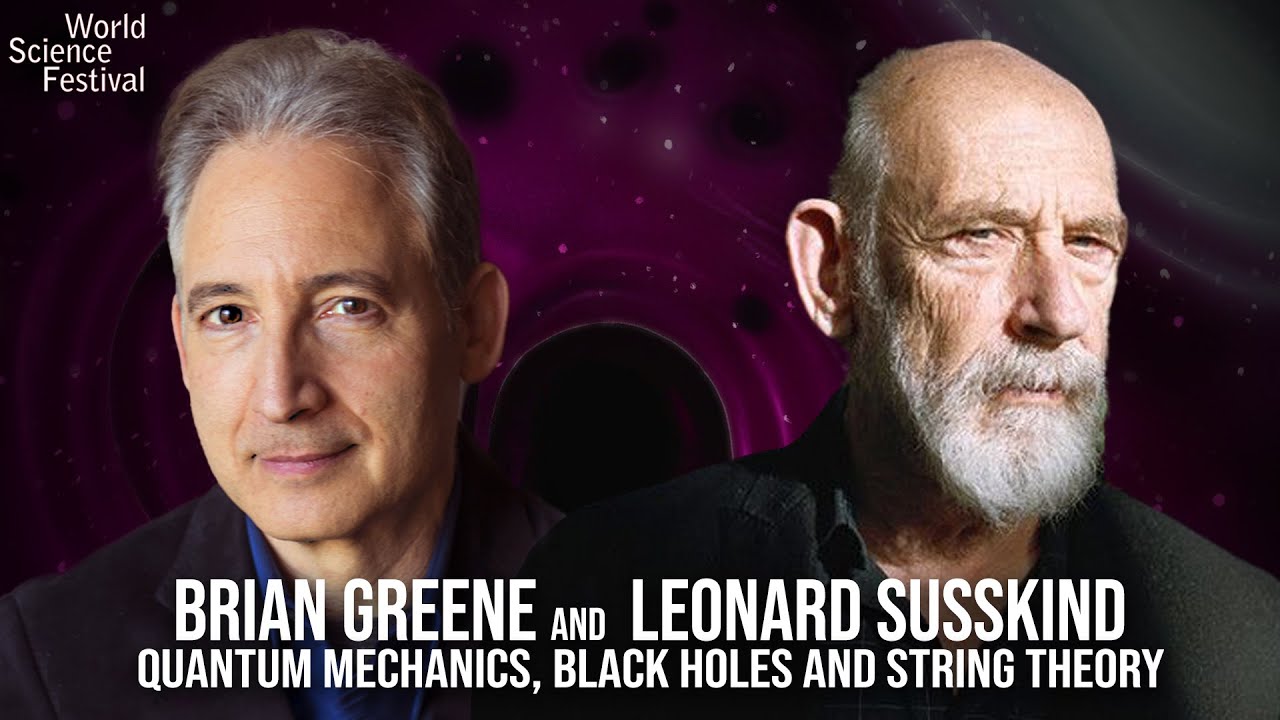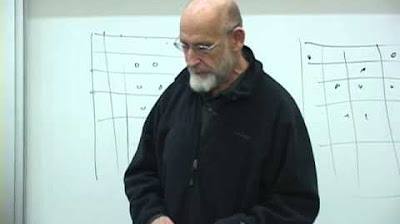Oxford University Mathematician REACTS to "Animation vs. Physics"
TLDRIn this video script, Dr. Tom Crawford reacts to the animation 'versus physics,' exploring various physics concepts through a visually engaging narrative. The script covers topics like projectile motion, gravity, stability, and the Lorentz factor, using creative visuals to illustrate these principles. As the video progresses, it delves into space exploration, black holes, quantum mechanics, and even touches on string theory. The script concludes with a humorous and somewhat confusing time-loop scenario, leaving viewers with a desire to understand more about the intricate world of physics.
Takeaways
- 🌌 The video begins with a journey through space, possibly continuing from a previous animation involving 'Orange Stickman'.
- 📏 Fundamental concepts of physics such as distance, velocity, and displacement are introduced using visual representations.
- 🚀 The video explores the idea of projectile motion and gravity, incorporating Newton's first law (mass * acceleration = force) into the narrative.
- 🔄 The concept of stability in physics is visualized, contrasting the unstable equilibrium at the top of a hill with the stable equilibrium at the bottom.
- 🌊 The video demonstrates the conservation of energy, showing the transformation between kinetic and potential energy.
- 🚀 A depiction of a rocket launch includes discussions on thrust and the equations associated with rocket propulsion.
- 🌟 The speed of light and the Lorentz factor from special relativity are introduced, illustrating the effects of time dilation as one approaches the cosmic speed limit.
- 🔭 The electromagnetic spectrum is explored, transitioning from visible light to UV and infrared, and even to gamma rays and radio waves.
- 🪐 The concept of a black hole is introduced, complete with an accretion disc, gravitational redshift, and the event horizon.
- 🤹♂️ Quantum physics is briefly touched upon, mentioning wave functions, superposition, and quantum entanglement.
- 🔄 The video concludes with a complex sequence involving wormholes, string theory, and a potential return to the beginning, leaving the viewer with many questions.
Q & A
What is the significance of the orange Stickman being teleported in the beginning of the video?
-The teleportation of the orange Stickman is a reference to the previous video 'Animation vs. Math' where he was teleported using the mathematical constant e or e to the power of pi. This sets the stage for the continuation of the series where mathematical and physical concepts are visualized and explored.
How does the video demonstrate the concept of displacement?
-Displacement is shown as the straight-line distance between two points, which is different from the path taken. In the video, as the Stickman moves, an arrow-like vector appears above his head to illustrate his velocity, while another vector represents the displacement, showing the distance between the starting and ending points.
What is the significance of the parabola shape in the video?
-The parabola shape is significant as it represents the trajectory of a projectile in motion, which is influenced only by gravity. The video uses this to demonstrate the concept of projectile motion and how it relates to the shape of a parabola, which is a key concept in physics.
How does the video illustrate the concept of force and friction?
-The video shows force and friction through the Stickman's interaction with different environments, such as when he slows down due to friction on ice. Force diagrams with arrows are used to visually represent the forces acting on the Stickman, including gravitational force, normal reaction force, and frictional force.
What is the concept of stability and equilibrium positions as shown in the video?
-Stability and equilibrium positions are demonstrated when the Stickman interacts with a ball on a hill. The top of the hill represents an unstable equilibrium position because a small nudge will cause the ball to roll down and not return to its original position. In contrast, the bottom of the valley represents a stable equilibrium position because a nudge will not change the ball's position.
How does the video use the concept of angular and linear momentum?
-The video shows the transformation of angular momentum into linear momentum. This is visualized when the Stickman creates angular momentum by spinning a rope, which he then uses to propel himself forward, demonstrating the conversion of rotational motion into linear motion.
What is the significance of the speed of light in the video?
-The speed of light, denoted as 'C', is a fundamental constant in physics. The video explores the concept of time dilation, a consequence of special relativity, where as an object approaches the speed of light, time slows down for that object relative to a stationary observer.
How does the video visualize the electromagnetic spectrum?
-The video visualizes the electromagnetic spectrum by showing how the wavelength of light changes color. It starts with visible light and moves to shorter wavelengths, such as ultraviolet (UV), and then to longer wavelengths, such as infrared, microwaves, and radio waves. This visualization helps to understand how different types of electromagnetic waves have different properties and applications.
What is the role of the accretion disc in the context of the video?
-The accretion disc is shown when the Stickman approaches a black hole. It represents the spiraling matter that accumulates around the black hole due to gravitational forces. The concept of an accretion disc is important in astrophysics as it is related to the formation and growth of black holes.
How does the video connect the concepts of quantum physics and entanglement?
-The video connects quantum physics and entanglement by showing two particles that are linked, regardless of the distance between them. This is a visual representation of quantum entanglement, where the state of one particle is dependent on the state of the other, and a change in one will instantaneously affect the other, a key principle in quantum mechanics.
What is the significance of the wormhole in the video's conclusion?
-The wormhole in the video's conclusion represents a hypothetical shortcut through spacetime, which is a concept in general relativity and string theory. The video suggests the idea of traveling through different dimensions or universes, which is a complex and fascinating topic in theoretical physics.
Outlines
📚 Introduction to the Video and Reaction to 'Animation vs Physics'
Dr. Tom Crawford begins by introducing himself and the purpose of the video, which is to react to the 'Animation vs Physics' video from the YouTube channel Alan Becka. He mentions his background as a mathematician at the University of Oxford and acknowledges that some parts of the video might be outside his area of expertise. Dr. Crawford expresses his curiosity about the video's content, especially since it follows up on the popular 'Animation vs Math' video. He also shares his excitement about the real-time reaction format and sets the scene for the viewer, mentioning that they are about to embark on a journey through space and physics concepts.
🚀 Exploration of Space and Physics Concepts
In this segment, Dr. Crawford delves into various physics concepts as they are visually represented in the video. He discusses the depiction of space, the use of a ruler to measure distance, and the representation of vector velocity and displacement. He appreciates the creativity and educational value of the video, noting the accurate portrayal of projectile motion and the role of gravity. Dr. Crawford also touches upon the concept of force diagrams and friction, highlighting the video's effective use of visual aids to explain complex ideas. He further discusses the transformation of angular momentum into linear momentum and the stability of a system, using the example of a ball rolling down a hill.
🌌 Deep Dive into Rocket Science and Relativity
This paragraph sees Dr. Crawford reacting to the rocket science and relativity aspects of the video. He talks about the depiction of a rocket, the equations associated with thrust, and the concept of the speed of light. Dr. Crawford explains the Lorentz factor and its relation to time dilation in special relativity, noting how time slows down as one approaches the speed of light. He also discusses the EM spectrum, the reflection of light, and the transition between different wavelengths. The video's exploration of the relationship between electricity and magnetism, as described by Maxwell's equations, is also highlighted by Dr. Crawford, who expresses his admiration for the mathematical beauty of these concepts.
🌠 Journey Through Black Holes, Quantum Physics, and Entanglement
In this part, Dr. Crawford explores the video's portrayal of black holes, quantum physics, and entanglement. He discusses the depiction of an accretion disc around a black hole, the concept of singularity, and the visual representation of various parts of a black hole. He also talks about the video's transition into quantum physics, including the mention of quantum entanglement and its significance in quantum computing. Dr. Crawford reflects on the complexity of quantum concepts and the potential of entangled particles to exist in multiple states simultaneously, until they are measured. He also touches upon the idea of quantum teleportation and the role of entanglement in it.
🔄 Concluding Thoughts and Reflections on the Video
Dr. Crawford concludes his reaction video by summarizing his thoughts and experiences while watching 'Animation vs Physics'. He admits to the complexity of the content and his limited physics knowledge, yet appreciates the opportunity to learn and visualize various physics concepts. He reflects on the video's narrative, the pranks with the apple, and the potential implications of time travel and wormholes. Despite not fully understanding the ending, Dr. Crawford expresses his gratitude to the viewers and the creator of the video, Alan Becka, for the educational and entertaining experience. He encourages viewers to explore his other content, particularly his reaction to 'Animation vs Math', and signs off with a promise of more mathematical fun in the future.
Mindmap
Keywords
💡Displacement
💡Velocity
💡Projectile Motion
💡Newton's First Law
💡Friction
💡Angular Momentum
💡Linear Stability
💡Kinetic Energy
💡Special Relativity
💡Magnetic Field
💡Quantum Entanglement
Highlights
Dr. Tom Crawford from the University of Oxford reacts to the video 'Animation vs. Physics'.
The video is a follow-up to the popular 'Animation vs. Math' video that Dr. Crawford previously reacted to.
Dr. Crawford, a mathematician, is unsure how he will understand all aspects of the physics-focused video.
The video begins with a character falling through space, possibly due to a teleportation event.
Physics concepts such as displacement, velocity, and acceleration are introduced through creative animations.
The video showcases projectile motion and the effects of gravity on the trajectory of a moving object.
Newton's first law (mass * acceleration = force) is visualized with a character experiencing different forces.
The concept of stability and equilibrium positions is explored with a ball on a hill.
The video demonstrates the conservation of energy through a series of movements and transformations.
The concept of angular momentum and its conversion to linear momentum is animated with a rotating ball.
The video includes a depiction of special relativity with the Lorentz factor and the effects of time dilation at near-light speeds.
Maxwell's equations, fundamental to electromagnetism, are alluded to in the video.
The video touches on quantum entanglement, a key concept in quantum physics and computing.
The video concludes with a mind-bending sequence involving wormholes, time travel, and self-interaction.
Dr. Crawford expresses his appreciation for the video's ability to visualize complex physics concepts.
Despite being a mathematician, Dr. Crawford finds value in the physics video and learns from its innovative approach.
Transcripts
Browse More Related Video

Dr. Michio Kaku Answers Physics Questions From Twitter | Tech Support | WIRED

The Trouble with Gravity: Why Can't Quantum Mechanics explain it?

Nerd Reacts to Animation vs Physics

Brian Greene and Leonard Susskind: Quantum Mechanics, Black Holes and String Theory

The Map of Black Holes | Black Holes Explained

Lecture 2 | Topics in String Theory
5.0 / 5 (0 votes)
Thanks for rating: